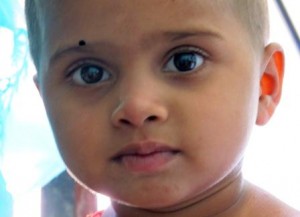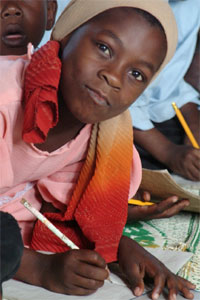1.2 Children's rights

What are children’s rights?
Ideas of childhood and social values vary considerably. While all societies recognize the difference between infancy, childhood, and adulthood, views vary about what childhood represents and what children are able to do and not do and how they should be treated.
Consider… A five-year-old cares for her sister alone
Before she heads off to work in a distant field, Kosala Devi feeds her two girls, washes their hands and faces, and prepares to leave. She locks the house behind her and leaves with her sickle and hoe…Read more
What do you think about this scenario?
Lalitha and Saritha are growing up in an environment where it is not unusual for children to take responsibility for their younger siblings. Do you think these children’s rights are being violated? Why or why not?
What children experience each day matters. The day-to-day moments of life are deeply felt. Feeling left out from a particular group of friends can be a strong, unpleasant experience. Even if minor experiences or worse don’t matter much in the long run of learning and development, they can make a very unhappy day for a small child.
A focus on a child’s rights to be happy and engaged is a focus on early childhood education in the immediate here and now rather than on what they will become in the future. Children’s early learning and development become by-products of the environments that children and early childhood educators create together.
United Nations Convention on the Rights of the Child (CRC)
The United Nations’ Convention on the Rights of the Child (CRC) was unanimously adopted by the United Nations in 1989. More countries adopted the CRC faster than any other human rights treaty. All United Nations member states, except for South Sudan and the United States, ratified the CRC. It put children’s rights on the political agendas of many countries.
The CRC outlines:
- the rights of children;
- what is needed in order to protect them; and
- what is needed to foster environments where they not only survive but thrive.
The articles of the CRC call for the provision of specific resources, skills, and contributions necessary to ensure the survival and development of children to their maximum capability and require the creation of means to protect children from neglect, exploitation, and abuse.
2019 marked the 30 year anniversary of the CRC. The UNICEF website is an excellent resource with a wealth of information about the CRC and highlights some of the achievements over the past 30 years as well as remaining challenges. As you explore, notice the increasing global trend of children taking matters into their own hands and demanding their rights.
The Child’s Rights International Network (CRIN) promotes the distribution and exchange of information and news related to child rights. CRIN educates, monitors, advocates, and lobbies for the implementation of the CRC and supports the activities of others in upholding children’s rights. Explore the CRIN website and check out the Rights Gallery.
What did you learn that was particularly significant to you from these two websites?
How does coming from a child rights perspective affect your work?
Helping children understand their rights
It is important that children understand their rights. UNICEF has taken the lead on making sure children understand their rights with a child-friendly version of the Convention on the Rights of the Child. The site below also includes resources for parents and teachers.
The following video, made by some early childhood education students, shows some Canadian children speaking about their rights.
Now watch as children with disabilities from around the world share their skills, their dreams and potential and call on the world to protect and promote their rights.
Why is it important that children are able to understand and articulate their rights?
Are children you know aware of their rights?
More and more children and youth are joining together to demand their rights, now and for the future, with regard to pressing matters such as climate change. How do you think this will affect policymakers and society at large?
Children living with disabilities have rights

The CRC applies to all children, including children living with disabilities. Research presented throughout this resource provides evidence that the prenatal and early years environments set the foundation for health and well-being. Interventions in the early years, when the brain is rapidly growing, are crucial in preventing potential delays in development. However, for children born with a disability, support and services are often few and far between, if available at all. Barriers, such as attitudes, policies, and physical accessibility, often exclude children with disabilities from participating in the daily life of their families and community.
How does it feel to be a child with a disability? The video in the link below contains the voices of children talking about stigma, challenges, rights, and dreams for the future.
Children with disabilities are one of the most marginalized and excluded groups in society. Facing daily discrimination in the form of negative attitudes, lack of adequate policies and legislation, they are effectively barred from realizing their rights to healthcare, education, and even survival” (UNICEF, n.d., para 1).
Holland Bloorview Kids Rehabilitation Hospital in Canada has worked closely with children and youth to understand and push for an end to the destructive stigma that children with disabilities experience. Explore their website about their campaign to promote inclusive messaging and advertising.
What are your main takeaways after reviewing the website?
How necessary are awareness-raising initiatives such as these to help improve circumstances for children with disabilities?
The Holland Bloorview Kids Rehabilitation Hospital in Canada examines the issue of stigma that children and youth with disabilities experience in the following reading.
Consider…Nasrin’s Day
Early in the morning, Nasrin, 5 years old, hears her mother get up and begin preparing the morning meal. She turns and watches her mother get the porridge ready…Read more
Nasrin is included in the daily activities of her family. What does this say about how Nasrin is regarded?
How is this supporting her development?
What about her participation in the life of the community? What are her opportunities and what are the barriers?
What do we know about people growing up and living with a disability? The following United Nations Enable infographic makes the point that without data on the lives of people who live with disabilities, the chances for inclusion in policies, programs, and services to improve their lives and wellbeing may be limited.
The next website, from WHO, tells us some key facts about how disabilities affect people worldwide.
Beliefs and attitudes about persons with disabilities vary widely around the world and influence policies and the provision of supports and services to enable them to fully participate in their societies. The United Nations Convention on the Rights of Children (CRC) along with the Convention on the Rights of Persons with Disabilities (CRPD) provides legal frameworks for defending and promoting the rights of children with disabilities.
In your context, are children with disabilities excluded from participating fully? Why or why not?
Are there policies to protect the rights of children with disabilities and are they implemented?
The United Nations General Assembly adopted the Convention on the Rights of Persons with Disabilities (CRPD) in 2006 and it entered into force in 2008. The CRPD is an international framework for recognizing, protecting, and promoting the rights of all persons with disabilities. The CRC applies to all children and the CRPD adds to the treaty agreements to ensure that human rights issues particular to persons with disabilities are made visible and addressed.
The next reading is about how children with disabilities, as with all children, should be active participants in making decisions about their lives.
Girls have rights

Sometimes simply being born a boy or girl can have major implications for a child’s rights. Gender discrimination against women and girls is a major issue in many parts of the world.
Although the Convention on the Rights of the Child (CRC), ratified by nearly every country, specifies that all children have a right to education, millions of girls around the world are getting little or no schooling.
In the next clip, listen to a mother describing why she pursued her own education through an adult preparation class as her children began formal schooling and the reason why she herself did not have the opportunity to go to school as a child.
Educating girls was not valued in Nabila’s household when she was a child. Now a grown woman, she has been given the opportunity to educate herself and has been able to take part. What social and cultural changes might have enabled this?
In what ways might Nabila’s decision to participate in an adult preparation class benefit her, her children, her family, and her community now and in the future?
The reasons for not attending vary and can range from a cultural or religious preference of schooling for boys to girls staying home to provide care to other children and family members, to issues around safety that do not allow girls to venture from their homes.
Girls’ education yields some of the highest returns of all development investments, yielding both private and social benefits that accrue to individuals, families, and society at large” (The World Bank, 2009).
In the next clip, Dr. Alex Awiti, founder and director of the East Africa Institute at the Aga Khan University, Nairobi, explains some of the benefits of investing in women.
What do you think the late Tanzanian President Mwalimu Julius Nyerere meant when he said “If you educate a woman, you educate the whole community. If you educate a man, you educate a single individual”.
How does investing in women’s health, education, employment opportunities, etc. influence home life, child well-being, communities, and societies?
What roles can fathers play to create more opportunities for women at home and in society?
PLAN International, is strongly committed to promoting gender equality globally through advancing girls’ rights.
What are trends in education for girls in your context?
Can you think of other aspects of girls’ lives where you live where they may experience discrimination?
Traditional stereotyped attitudes about male and female roles are changing. Many men want to raise their children, both girls and boys, with more equity. We will end this page with a video from the MenCare Movement.
There will be more information on gender equity on page 2.2 in this module.
COVID-19 pandemic and children’s rights
The impact of COVID-19 on the lives of children around the world is extensive and children living in challenging circumstances particularly experiencing even more hardship. The Lancet editorial below outlines why children’s rights must be a key component of the pandemic response and future planning to provide a more equitable world for children.
As part of Save the Children’s global research study, the following report, The hidden impact of COVID-19 on child rights (2020), presents their findings on how children’s rights have been affected due to the global pandemic. The infographic on page 4 summarizes their findings and the Executive Summary provides further information (pages 6-10).
The Child Rights International Network (CRIN) is “…producing a series of features exploring how the pandemic and the measures to prevent its spread impact the human rights of under-18s.” Visit their website to learn more.



